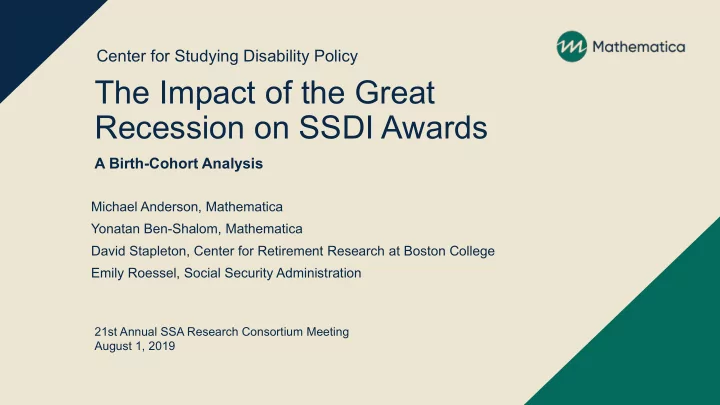

Center for Studying Disability Policy The Impact of the Great Recession on SSDI Awards A Birth-Cohort Analysis Michael Anderson, Mathematica Yonatan Ben-Shalom, Mathematica David Stapleton, Center for Retirement Research at Boston College Emily Roessel, Social Security Administration 21st Annual SSA Research Consortium Meeting August 1, 2019
This research was supported by a grant from the U.S. Social Security Administration (SSA) as part of the Disability Research Consortium. The findings and conclusions are solely those of the authors and do not represent the views of SSA, any agency of the federal government, Mathematica, or the Center for Retirement Research at Boston College. Center for Studying Disability Policy
SSDI awards began to decline in 2011 Social Security Disability Insurance (SSDI) awards and recessions, 1965 to 2018 1200 1000 SSDI awards (1,000s) 800 600 400 200 0 1965 1970 1975 1980 1985 1990 1995 2000 2005 2010 2015 Great Recession Recession Awards (1,000s) Center for Studying Disability Policy 3
Forecasting is difficult when awards fluctuate SSDI awards and projected date of SSDI Trust Fund depletion 1200 2060 Projected year of Trust Fund depletion 2052 1000 2050 SSDI awards (1,000s) 800 2040 600 2032 Passage of Bipartisan 2030 2026 400 2028 Budget Act of 2015 2023 2020 200 2016 0 2010 2007 2008 2009 2010 2011 2012 2013 2014 2015 2016 2017 2018 2019 Calendar year / report year Great Recession Awards (1,000s) Projection for DI Trust Fund depletion Center for Studying Disability Policy 4
The dynamic effect of recessions on awards The recession ended in 2009 The lag in the impact of the recession depends on the worker's path from layoff to award: • Apply immediately after layoff • Exhaust Unemployment Insurance before application (maximum duration extended in this period) Search for work before application • • Onset of disability follows job loss Maestas et al. (2018): recession induced 400,000 SSDI awards between 2008 and 2012 In the recovery period: • Reductions in layoffs reduce awards to those newly laid off More unemployed workers at risk for SSDI are able to find jobs • Center for Studying Disability Policy 5
Did the Great Recession lead to a reduction in awards after 2010? Acceleration hypothesis: The recession accelerated awards to some workers who would have applied and been awarded • benefits later in the period had the recession not occurred Acceleration of awards contributed to both the initial increase and the later decline • Center for Studying Disability Policy 6
Empirical strategy Analyze individual birth-year cohorts: • Construct counterfactual: expected awards if no recession Measure the deviation between observed awards and the counterfactual • • Predict deviation using cross-state variation in the business cycle Novelties • Birth-cohort method: needed to test the acceleration hypothesis; avoids confounding of changes in age/sex composition of labor force • Business-cycle measure: employment ratio not sensitive to “discouraged worker” effect Center for Studying Disability Policy 7
Counterfactual awards Counterfactual: estimate of awards in 2008 to 2014 if no recession Data: 2016 Disability Analysis File SSDI awards in 1996–2014 Beneficiaries age 20 to 65 in 2007 Example: projected award growth for a 55-year-old female in Ohio is based on: Ohio females born in: Award growth at age 55 from: 1942 1996 to 1997 1943 1997 to 1998 … … 1951 2005 to 2006 Use the counterfactual growth rates to construct counterfactual awards in 2008 through 2014 Center for Studying Disability Policy 8
For males, the early increase is offset by a later decrease 300,000 250,000 200,000 Awards 150,000 100,000 50,000 0 2008 2009 2010 2011 2012 2013 2014 Observed awards Counterfactual awards Note: figure shows males born from 1941 to 1986. Center for Studying Disability Policy 9
For females, the counterfactual is too steep 300,000 250,000 200,000 Awards 150,000 100,000 50,000 0 2008 2009 2010 2011 2012 2013 2014 Observed awards Counterfactual awards Note: figure shows females born from 1941 to 1986. Center for Studying Disability Policy 10
Three variables to characterize the business cycle 0.64 1. Sept. 2007 employment rate 0.63 0.62 2. Decline from Employment rate 0.61 Sept. 2007 to Dec. 2009 0.6 0.59 0.58 3. Recovery from Dec. 2009 to Dec. 0.57 2016 0.56 0.55 2007 2008 2009 2010 2011 2012 2013 2014 2015 2016 Source: Local Area Unemployment Statistics. Center for Studying Disability Policy 11
Cross state regression models Estimate models by birth-year and sex in 6-month periods from 2008 through 2014 Dependent variable: deviation of observed awards from counterfactual Explanatory variables: the business cycle variables and an intercept Business cycle component: awards predicted by the business cycle variables Center for Studying Disability Policy 12
The business cycle predicts a decline in awards starting in 2012 100,000 80,000 60,000 40,000 20,000 Awards 0 2008 2009 2010 2011 2012 2013 2014 -20,000 -40,000 -60,000 -80,000 -100,000 Note: Figure shows awards predicted by the business cycle for males born in 1941 through 1986. Center for Studying Disability Policy 13
Results are driven by males age 49 to 59 in 2008 60,000 40,000 20,000 Awards 0 2008 2009 2010 2011 2012 2013 2014 -20,000 -40,000 -60,000 -80,000 1941-1948 1949-1959 1960-1969 1970-1979 1980-1986 Note: Figure shows males born in 1941 through 1986, by cohort group. Center for Studying Disability Policy 14
Conclusions Acceleration is most evident for men who were age 49 to 59 at the beginning of the recession A large share of the decline in awards since 2011 is due to the Great Recession This effect is temporary The contribution of other factors, including long-term factors, is smaller than we would otherwise think Implications for projections of the SSDI Trust Fund depletion: Current projections may be too optimistic • • Previous projections too dire Center for Studying Disability Policy 15
Future work Address issue with counterfactual for females Characterization of the business cycle: Sex-specific employment rates Time-varying Center for Studying Disability Policy 16
Thank you Please address questions to Mike Anderson: mtanderson@mathematica-mpr.com Center for Studying Disability Policy 17
Recommend
More recommend